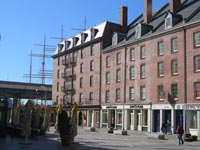 The restored South Street Seaport, on New York’s City’s East River, has always been an uneasy balance between a historic seaport and a real estate deal. South Street is now far more shopping mall than historic seaport. The current museum chairman, Frank J. Sciame, is himself a real estate developer. Depending on who one asks, Sciame is either the museum’s savior or its destroyer. Since March, Mr. Sciame has lent the museum $3 million to cover operating expenses. Over the last three weeks, seven of the 21 trustees resigned from the museum board, and according to sources at the Seaport, twelve employees were furloughed on Monday, leaving at most a skeleton staff to continue Seaport operations. Whether the Seaport Museum will survive its current financial crisis is unclear.
The restored South Street Seaport, on New York’s City’s East River, has always been an uneasy balance between a historic seaport and a real estate deal. South Street is now far more shopping mall than historic seaport. The current museum chairman, Frank J. Sciame, is himself a real estate developer. Depending on who one asks, Sciame is either the museum’s savior or its destroyer. Since March, Mr. Sciame has lent the museum $3 million to cover operating expenses. Over the last three weeks, seven of the 21 trustees resigned from the museum board, and according to sources at the Seaport, twelve employees were furloughed on Monday, leaving at most a skeleton staff to continue Seaport operations. Whether the Seaport Museum will survive its current financial crisis is unclear.
As reported in yesterday’s New York Times:
“There’s no question that we are dealing with some significant hurdles,” said Peter Gates, who remains on the board. “Frank has brought a truly remarkable level of energy, determination and judgment to the museum. These qualities combined with his great generosity have kept the museum going, and we are grateful to him.”
“Frank Sciame is doing incalculable harm to the Seaport Museum,” said one furloughed employee, who did not want to be identified because of fear of reprisal for speaking publicly. “He has refused overtures from the city to help stabilize the museum and has driven away trustees who resent his high-handed and confrontational manner. It’s hard to kill a nonprofit, but Sciame is well on the way to accomplishing just that.”
In many respects, the conflict between the museum and development has gone on for its entire history. From Seaport Museum by Vladimir Tchikrizov:
In December of 1977 the museum signed an agreement with the Rouse Company for a feasibility study for the possibility of development of an urban marketplace. In 1979, a $210-million development plan was agreed on. In 1983 the Rouse Company finished the Fulton Marketplace, and in 1985 the Pier 17 mall.
For the museum, monetary troubles continued. As most of the profits from the area went to the development corporation and the city, the museum saw little of the money. In 1982 it was forced to lay off more staff, leaving only 50 employees. Despite the finished commercial development, the museum struggled : it saw no support from the real estate corporation, staff salaries were cut, and a complete shut down of the museum was considered. In effect, the museum was controlled by the corporation which was set up to channel revenues to it. Jakob Isbrandtsen stated that the corporation used the museum “…as an umbrella to make the real estate successful.”
Real estate and profit concerns detracted from one of the South Street Seaport Museum’s major goals : preservation of historic ships. The costly upkeep and renovation of ships – in 1987 alone it cost the museum $836,33613 – simply became secondary. Lettie G. Howard, the eventual restoration of which cost $1 million, was reduced to a “rotting hulk”14 by 1988 due to neglect.

ah.
I had seen a comment on Will’s facebook page about an ice yacht moldering away in a pile of junk aboard the Peking, and there was a reference to “Now that nobody works there…”
What a shame it would be to lose the museum. I’ve always enjoyed my visits there.
Pingback: Two Museums, Two Coasts, Very Different Prospects : Old Salt Blog – a virtual port of call for all those who love the sea
Pingback: Still a Work in Progress, the South Street Seaport Museum Reopens | Old Salt Blog – a virtual port of call for all those who love the sea